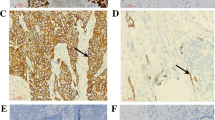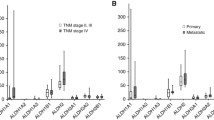Abstract
Receptor for advanced glycation end products (RAGE) is associated with invasion, metastasis, and poor prognosis in colorectal cancer. We studied the expression of RAGE in colorectal adenomas to elucidate the role of RAGE in cancer development. Expressions of RAGE and high-mobility group box-1 (HMGB1)/amphoterin RAGE ligand were examined in 96 colorectal adenomas using immunohistochemistry and in situ hybridization, respectively. Positivity and expression pattern of RAGE were compared with atypia, histological types, size, and HMGB1/amphoterin expression. Of 96 adenomas, 34 (35%) showed RAGE expression. RAGE positivity was significantly higher in adenomas with severe atypia (18/20, P<0.0001) and large-sized adenomas (−15 mm) (18/22, P<0.0001). RAGE expression showed three patterns: cytosolic (n=10), luminal (n=14), and membranous (n=10). Cytosolic pattern was associated with mild atypia and small size (−5 mm). Membranous pattern was associated with severe atypia, villous histological type, and co-expression with overexpressed HMGB1/amphoterin. These results suggest that RAGE expression, especially with membranous pattern, is associated with malignant potential of colorectal adenomas.


Similar content being viewed by others
References
Abe R, Shimizu T, Sugawara H, Watanabe H, Nakamura H, Choei H, Sasaki N, Yamagishi S, Takeuchi M, Shimizu H (2004) Regulation of human melanoma growth and metastasis by AGE–AGE receptor interactions. J Invest Dermatol 122:461–467
Coutsoftides T, Lavery I, Benjamin SP, Sivak MVJ (1979) Malignant polyps of the colon and rectum: a clinicopathologic study. Dis Colon Rectum 22:82–86
Fages C, Nolo R, Huttunen HJ, Eskelinen E, Rauvala H (2000) Regulation of cell migration by amphoterin. J Cell Sci 113:611–620
Fenoglio-Preiser CM, Hutter RV (1985) Colorectal polyps: pathologic diagnosis and clinical significance. CA Cancer J Clin 35:322–344
Hsieh HL, Schafer BW, Weigle B, Heizmann CW (2004) S100 protein translocation in response to extracellular S100 is mediated by receptor for advanced glycation endproducts in human endothelial cells. Biochem Biophys Res Commun 316:949–959
Kuniyasu H, Chihara Y, Kondo H (2003) Differential effects between amphoterin and advanced glycation end products on colon cancer cells. Int J Cancer 104:722–727
Kuniyasu H, Chihara Y, Kondo H, Ohmori H, Ukai R (2003) Amphoterin induction in prostatic stromal cells by androgen deprivation is associated with metastatic prostate cancer. Oncol Rep 10:1863–1868
Kuniyasu H, Chihara Y, Takahashi T (2003) Co-expression of receptor for advanced glycation end products and the ligand amphoterin associates closely with metastasis of colorectal cancer. Oncol Rep 10:445–448
Kuniyasu H, Oue N, Wakikawa A, Shigeishi H, Matsutani N, Kuraoka K, Ito R, Yokozaki H, Yasui W (2002) Expression of receptors for advanced glycation end-products (RAGE) is closely associated with the invasive and metastatic activity of gastric cancer. J Pathol 196:163–170
Schmidt AM, Hofmann M, Taguchi A, Yan SD, Stern DM (2000) RAGE: a multiligand receptor contributing to the cellular response in diabetic vasculopathy and inflammation. Semin Thromb Hemost 26:485–493
Schmidt AM, Yan SD, Yan SF, Stern DM (2001) The multiligand receptor RAGE as a progression factor amplifying immune and inflammatory responses. J Clin Invest 108:949–955
Taguchi A, Blood DC, del Toro G, Canet A, Lee DC, Qu W, Tanji N, Lu Y, Lalla E, Fu C, Hofmann MA, Kislinger T, Ingram M, Lu A, Tanaka H, Hori O, Ogawa S, Stern DM, Schmidt AM (2000) Blockade of RAGE-amphoterin signalling suppresses tumour growth and metastases. Nature 405:354–360
Vogelstein B, Fearon ER, Hamilton SR, Kern SE, Preisinger AC, Leppert M, Nakamura Y, White R, Smits AM, Bos JL (1988) Genetic alterations during colorectal-tumor development. N Engl J Med 319:525–532
Yan SD, Chen X, Fu J, Chen M, Zhu H, Roher A, Slattery T, Zhao L, Nagashima M, Morser J, Migheli A, Nawroth P, Stern D, Schmidt AM (1996) RAGE and amyloid-beta peptide neurotoxicity in Alzheimer’s disease. Nature 382:685–691
Yasui W, Akama Y, Yokozaki H, Semba S, Kudo Y, Shimamoto F, Tahara E (1997) Expression of p21WAF1/CIP1 in colorectal adenomas and adenocarcinomas and its correlation with p53 protein expression. Pathol Int 47:470–477
Acknowledgements
This work was supported in part by Grant-in-Aid for Scientific Research from The Ministry of Education, Culture, Sports, Science and Technology, Japan.
Author information
Authors and Affiliations
Corresponding author
Rights and permissions
About this article
Cite this article
Sasahira, T., Akama, Y., Fujii, K. et al. Expression of receptor for advanced glycation end products and HMGB1/amphoterin in colorectal adenomas. Virchows Arch 446, 411–415 (2005). https://doi.org/10.1007/s00428-005-1210-x
Received:
Accepted:
Published:
Issue Date:
DOI: https://doi.org/10.1007/s00428-005-1210-x




